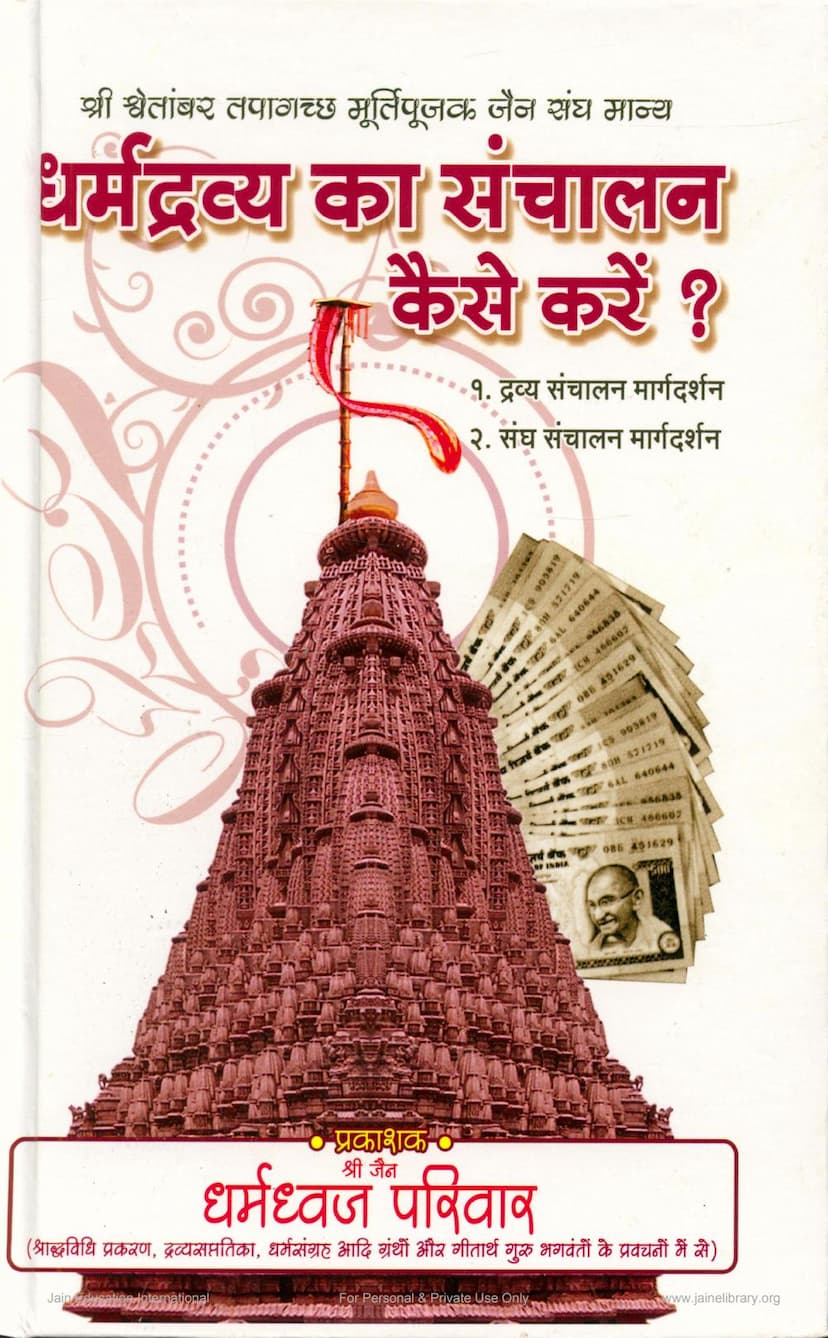Dharmdravya Ka Sanchalan Kaise Kare
Added to library: September 1, 2025

Summary
The book "Dharmdravya ka Sanchalan Kaise kare" (How to Manage Religious Funds) by Dharmdhwaj Parivar, is a comprehensive guide to the proper management and utilization of Jain religious funds, adhering to scriptures and the teachings of esteemed Gurus. The book emphasizes the critical importance of correctly handling "Dharmdravya" (religious funds) according to Jin's (Lord Mahavir's) commands for the sustenance and flourishing of Jainism for the stipulated 21,000 years.
The core message revolves around the "Seven Areas" (Saat Kshetra) of Jainism, which are fundamental to its functioning and the spiritual well-being of its followers. These seven areas are:
- Jina Pratima Kshetra (Area of Idol worship/Deities)
- Jina Mandir Kshetra (Area of Temples)
- Jina Āgam Kshetra (Area of scriptures/knowledge)
- Sadhu Kshetra (Area of Monks)
- Sādhvi Kshetra (Area of Nuns)
- Shravak Kshetra (Area of male devotees/followers)
- Shravika Kshetra (Area of female devotees/followers)
The book meticulously outlines the correct principles for the financial management (Dravya Sanchalan) of funds designated for each of these seven areas, as well as other categories of religious funds like Guru Dravya, Sadharan Dravya, and Jeevdaya (animal welfare).
Key Themes and Guidance Provided:
- Adherence to Jin's Teachings: The book repeatedly stresses that all financial dealings must be strictly in accordance with the divine commands (Jin's Āgnā) as laid down in the scriptures. Deviation from these principles is considered a serious transgression with severe karmic consequences.
- Importance of the Seven Areas: The seven areas are considered the pillars of the Jain faith, akin to the head and body. Their proper maintenance and functioning are crucial for the propagation of Jainism.
- Prohibition of Misappropriation: The text strongly condemns any misuse, misappropriation, or neglect of Dharmdravya. It details grave consequences, including rebirths in lower realms, poverty, and suffering, for those who indulge in such acts. Several cautionary examples from Jain history are cited.
- Specific Guidelines for Each Fund Category:
- Devdravya (Funds for Deities/Temples): This is primarily for the construction, renovation, and maintenance of temples and idols. It also covers expenses related to deity adornments, rituals, and protection. The book clarifies that while Shravaks (devotees) should ideally perform puja with their own funds, Devdravya can be used as an exception for puja expenses if Shravaks are unable to do so, ensuring the deity is never left un-worshipped. It strongly discourages the use of Devdravya for any other purpose, including social welfare or personal benefit.
- Jina Āgam/Gyan Dravya (Funds for Scriptures/Knowledge): This is strictly for the preservation, printing, and dissemination of Jain scriptures and knowledge. It includes establishing libraries, supporting scholars, and educating individuals in Jain philosophy. It specifically prohibits the use of this fund for schools or general secular education.
- Sadhu-Sādhvi Vairavach Dravya (Funds for Monks and Nuns): This is for the upkeep and service of Jain ascetics, including their provisions, lodging, and medical needs. However, it strictly prohibits the construction of Upashrayas (monasteries/residences for ascetics) or providing them with modern amenities like electric fans, coolers, or mobile phones using this fund.
- Shravak-Shravika Dravya (Funds for Devotees): This is meant for helping needy Shravaks and Shravikas, especially during times of crisis, and fostering camaraderie within the community (Sādharmik Bhakti). It is explicitly stated that this fund cannot be used for general charity, public welfare, or animal welfare activities.
- Guru Dravya: Funds collected through the worship of Gurus are primarily to be used for the renovation or construction of temples, as Gurus themselves are ascetics and do not possess personal wealth.
- Sadharan Dravya (General Funds): This is a more flexible fund that can be used for various activities supporting the Jain community and its infrastructure, such as office expenses, temple maintenance (non-specific), and support for essential services within the community. However, even this fund has limitations and cannot be used for non-religious or unethical purposes.
- Jeevdaya and Anukampa Dravya (Funds for Animal Welfare and Compassion): These funds are strictly for the welfare of animals and birds and cannot be diverted to any of the seven areas of religious funds or human welfare activities.
- Banning of Misguided Practices: The book actively discourages and refutes practices that deviate from scriptural norms, such as using Devdravya for secular purposes, building hospitals or marriage halls in Upashrayas, promoting modern amenities for ascetics, or engaging in unscriptural pujas.
- Transparency and Accountability: It emphasizes the need for meticulous record-keeping, transparency in financial transactions, and regular audits to maintain the trust of donors and the sanctity of the funds.
- Role of Gurus: The book highlights the indispensable role of learned and virtuous Jain monks (Gitārth Gurus) in guiding the correct interpretation and application of scriptural rules for managing Dharmdravya. Decisions regarding any exceptions or interpretations of rules should be taken only under their guidance.
- The "Seven Areas" as the Highest Priority: The book consistently reiterates that the seven areas hold the highest religious significance, and their welfare is paramount. Funds designated for these areas cannot be used for any other purpose, including social welfare or animal welfare, which are considered secondary to the core religious activities.
In essence, "Dharmdravya ka Sanchalan Kaise kare" serves as a sacred manual for the Jain community, providing clear scriptural directives on financial stewardship, ensuring that every rupee of religious donation is utilized appropriately and ethically to uphold the sanctity and propagation of Jainism. It acts as a powerful tool against financial mismanagement and promotes a deeper understanding of the spiritual responsibility associated with handling Dharmdravya.